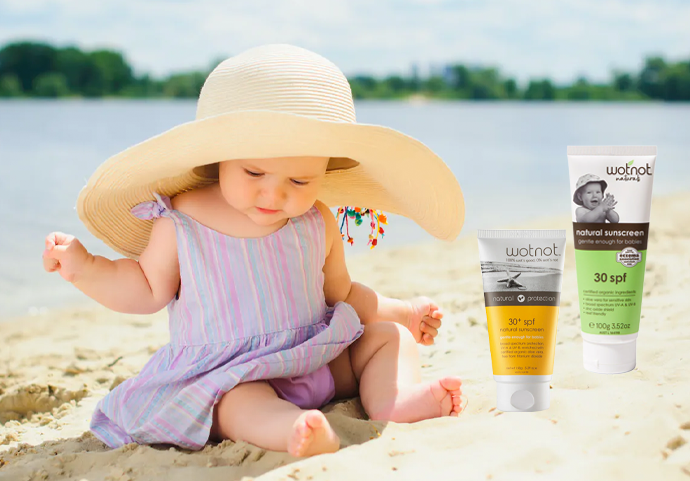Although sunshine can make you feel good and exposure to sun rays can boost serotonin levels, it can also harm your skin. This is why it’s so vital to use sunscreen. Spending too much time in the sun without sufficient protection can cause wrinkles, premature ageing, and even skin cancer. Additionally, sunscreen can help protect your skin, even in the winter, when you don’t even feel the sun.
However, not all sunscreens are the same. Chemical sunscreens can sometimes cause more harm than good. It would help if you used natural sunscreen to protect your skin in the safest method possible. Natural sunscreen has more advantages than protecting your skin from dangerous UV rays. Unlike chemical sunscreens, natural ones do not contain any additional hazardousus compounds.

Why Should I Use Natural Sunscreen?
Since the purpose of summer is pleasure and leisure, make sure you always have the right natural sunscreen by your side. Besides being free of oxybenzone, avobenzone, octinoxate, and other potentially dangerous components, here are some of the many reasons why you should always opt for natural instead of chemical sunscreen.
Healthier for Your Baby
Chemical sunscreen ingredients like avobenzone, oxybenzone, octocyrlene, and ecamsule are absorbed into the bloodstream through the skin in both children and adults, potentially disrupting hormones. Because babies and children have a higher surface area-to-body weight ratio and higher absorption rates, toxins can bioaccumulate faster in their systems, resulting in a more hazardous effect.
It is strongly advised to avoid applying sunscreen on babies under six months. If you must use sunscreen, search for a mineral-based lotion that contains zinc oxide or titanium dioxide and apply it just to your hands and face, keeping the sunscreen out of your child’s eyes. Stop using it if any skin irritation occurs.
If you are looking for the best natural sunscreen, you should try the non-toxic, natural Wotnot baby sunscreen for maximum UVA and UVB-rays protection. Wotnot is an Australian made company whose certified formulas are close to nature. They use the finest and most gentle natural extracts in their production.

Our top pick, the 30 SPF Natural Wotnot baby sunscreen, is rich in zinc oxide and free from GMOs, sulphates, petrochemicals, parabens, artificial preservatives, and fragrances. You can use it on babies from 3 months of age, even for those with the most delicate skin. Babies under this age should avoid direct sun exposure.
Ideal for All Skin Types
Even while chemical sunscreens stay in the skin, not everyone will react negatively. However, the chemical ingredients in sunscreen may have unintended consequences for your health.
Several studies have recently highlighted various health risks associated with chemical sunscreen ingredients. These range from increased free radicals in the skin to endocrine-disrupting properties in the body and, ironically, an increased risk of melanoma in cases of intentional sun exposure using sunscreen.
Chemical sunscreen brands produce allergic reactions and hyper-sensitivities to sunscreen, which are at an all-time high among young people. As a result, natural sunscreens are also skin-safe. Dermatologists advise people with sensitive, acne-prone skin to avoid harsh chemical sunscreens and opt for natural, gentler options. All Wotnot’s products are designed with the most delicate skin in mind. Eczema, psoriasis, and rosacea sufferers have used and loved them for years. They recommend patch testing first to ensure no allergic reactions.

A Higher Level of Opacity
Synthetic and natural sunscreens soaking into the skin is the most noticeable difference. Natural sunscreens have a somewhat different texture and viscosity than conventional sunscreens. It’s thicker and may take a little extra rubbing to absorb it completely. If you’re used to synthetic sunscreens disappearing into your skin with no trace, you might be shocked when you use natural sunscreen for the first time. Depending on the type and formulation, they can leave anything from a small opaque film to full-on white streaks.
Zinc oxide and titanium dioxide are white minerals that do not permeate the skin in their natural state. Instead, they sit on top of the building to keep the sun out. Wotnot’s 30SPF Natural Sunscreen is a lovely, pure product that effortlessly glides across the skin. Enriched with zinc oxide, shea butter, jojoba, and safflower oils, it leaves your skin feeling supple, nourished, and soft.
Reef-Friendly
Unfortunately, the word “reef-friendly” is not regulated, so you can’t always rely on products that claim to be “reef-friendly.” The term “reef safe” usually refers to the presence of solely mineral UV-blocking compounds such as oxide and titanium dioxide in the sunscreen. Traditional zinc oxide sunscreens and nanoparticle (smaller particle size) sunscreens are both safe and effective, and both will be regarded as safe for reefs. The only difference is the skin’s aesthetic sensation.
The secret to keeping the ocean’s life happy is to use an SPF with actual UVA and UVB filters instead of the chemical ones connected to coral reef deterioration. All Wotnot’s products are reef-friendly and free from nasty toxins and chemicals. Moreover, their tubes are made with renewable energy from solar farms, are 100% recyclable, and may be thrown away in municipal recycling bins.

How to Choose the Best Natural Sunscreen
Check Out the Active Ingredients
You’re looking for zinc oxide, either alone or in combination with titanium dioxide. Zinc oxide has a broad-spectrum SPF, which means it protects you from UVA and UVB radiation. Titanium dioxide is mainly effective against UVB; therefore, it won’t protect you over the entire spectrum and shouldn’t be used alone. However, it can help zinc oxide work more effectively.
Opt for an SPF of 30 or Higher
Your sun protection factor (SPF) should be at least 30. This ensures that you are adequately protected for a reasonable amount of time. SPF can go up to 50+. However, the increase in sun protection after SPF 30 is only gradual.
Consider the Other Ingredients
So, if you’re seeking a more natural sunscreen solution, you’ll have to do some research. The presence of natural active components in sunscreen does not imply that it is 100 per cent natural. The vehicle, which includes all of the other ingredients in the sunscreen, could still be synthetic. This doesn’t mean the sunscreen is inherently better or worse than others. It all boils down to your particular preferences and the type of thing you’re looking for.
Micronized Vs a Non-Nano Particles Product
A sunscreen with the word “micronized” on the front or active ingredients will absorb more quickly and leave slight opacity on the skin. This will give you a finished product that resembles the synthetic sunscreens you’re used to. Non-micronized or non-nano goods, on the other hand, leave a white film on the skin’s surface that you can’t massage in.



